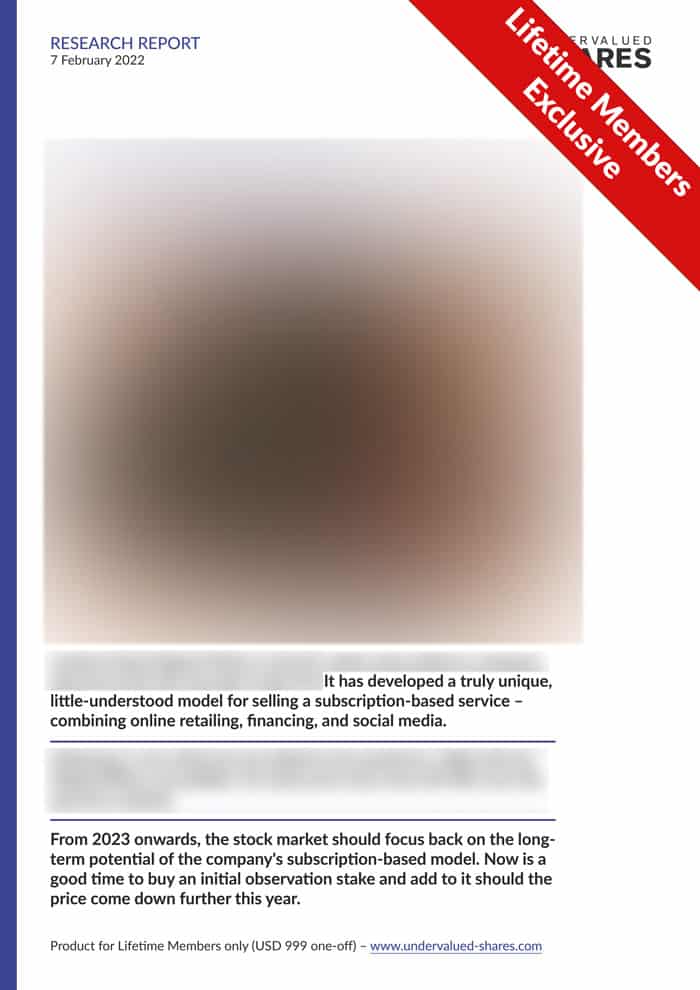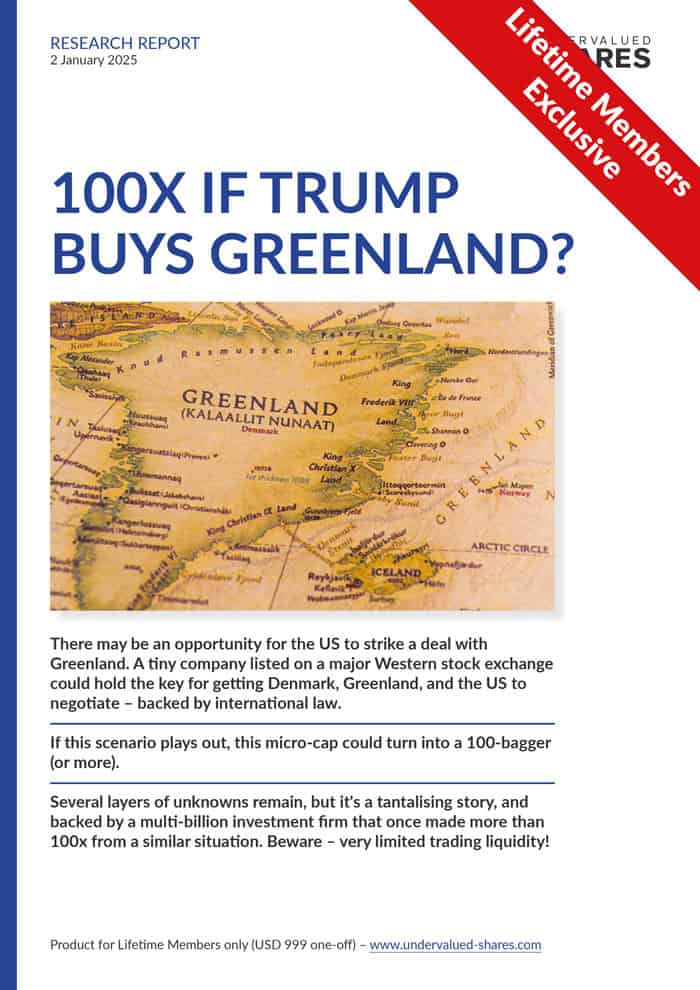Did you know that the Wall Street Journal originally started as a two-page daily investment newsletter?
It was only in 1889 - seven years after its launch - that the Customer Afternoon Letter was converted into a newspaper. Until then, what is today one of the world's premier financial newspapers was a mixture of a Substack and a Twitter account, only in hardcopy.
Who'd have thought?
Investment newsletters have a colourful, fascinating history. They are useful for investors who are seeking an alternative point of view and fresh investment ideas. For those inclined to write and publish, they can also be a marvellous business because they offer subscription-based, recurring income that readers pay upfront.
I have been involved with the investment newsletter industry for over 25 years, both as a reader and publisher, and accumulated quite a body of knowledge.
What's the best way to benefit from those newsletters, and how can you set one up for yourself and possibly even get help in starting out?
Today's slightly off-piste Weekly Dispatch - the final part of my series about subscription-based businesses - has the answers.
What's a "newsletter" these days?
There has never been a clear definition of what constitutes an investment newsletter, and technology has made this even more confusing.
Does a blog count as an investment newsletter? Can a Twitter account qualify as a newsletter-style publication?
Newsletters can come in various formats. Whenever I speak of investment newsletters, I don't necessarily refer to actual "letters". Check out my "Blogs to Watch" article about 10-K Diver, an investment publication published in the form of lengthy Twitter threads.
It's not the format that matters, but what's in it. Or as a former boss of mine used to say in the 1990s: "If it's a good stock tip, we could print the name of the stock on the back of a stamp and people would still pay for it."
In my understanding, an investment newsletter will generally:
- Offer viewpoints that you can't easily find in corporate media or brokerage research.
- Be written by one individual, or maybe a small team.
- Have something "edgy", such as a controversial core thesis (such as James Grant's view of central banks), a fun appearance (such as the Bear Traps Report's quirky format), or strong political viewpoints interwoven with investment matters (such as the writing of "Quoth the Raven", the anonymous author of QTR's Fringe Finance).
Most such publications come with relatively high price tags, at least compared to the price of newspapers and magazines and when calculated on a per-page basis.
However, nothing is set in stone.
E.g., does Undervalued-Shares.com count as an investment newsletter?
My 20-100-page research reports barely qualify as "letter" in the conventional sense, but they are de facto a letter from me to my readers.
How it all began for me
When I was 16, I regularly skipped school to go to shareholder meetings. My parents somewhat approved of it, but whether I was allowed to do any of this was definitely a grey area. I still wonder how my teachers let me get away with regular truancy.
Asking lots of questions at shareholder meetings in and around Frankfurt, I caught the eye of the editor-in-chief of the Frankfurter Börsenbriefe (literally: "Frankfurt Stock Market Letters"). At the time, this was one of the most powerful investment newsletters in Germany.
The Frankfurter Börsenbriefe were one of a handful of investment publications that had sprung up in post-war Germany. The eight-page letters were mailed out as hardcopy every week, with lots of market commentary and stock tips. Just about every bank in Germany had subscribed to those letters and made them available in their lobbies for customers to read for free. This was the pre-Internet version of viral content.
At an annual subscription price of 600 Deutschmarks and with 5,000 subscriptions in total, the Frankfurter Börsenbriefe brought in revenue of about 3m Deutschmarks a year. This was around USD 2m, at a time when the purchase power of the dollar was still a lot higher and a can of Coca-Cola cost 0.19 Deutschmark (a random price point I happen to remember). The publication employed just its editor and a PA, and its main cost for an office wasn't the office space as such but the storage of decades of invaluable archival material about German companies.
In short, this was an insanely profitable publication.
The editor, Heinz Schollmeyer, took a liking to this 16-year-old who asked CEOs incessant questions, and asked me if I'd like to write for his publication. I was subsequently paid a retainer of 400 Deutschmarks a month - a small fortune for anyone aged 16 in early 1990s Germany.
By age 19, I was raking in close to 10,000 Deutschmarks a month by writing several newsletters. My income was the equivalent of what a reasonably senior executive would have earned at the time. I single-handedly churned out the monthly Emerging Market Letter (2,800 Deutschmarks a month) and the weekly Hanseatischer Börsendienst (4,000 Deutschmarks a month), besides a few other gigs.
In a very different way than today, these were golden days.
Much as we have exciting technology nowadays to reach readers around the world and publish in an almost instant manner, these days long past offered other opportunities to give your readers an edge. E.g., insider trading didn't become illegal in Germany until 1 August 1994. I had one instance where a real estate company's CEO told me that the company was about to announce a significant rise of its dividend. My readers heard about it before the official announcement and made out like bandits.
This incidence inspired my 7 May 2021 Weekly Dispatch: "Should insider trading be legalised?" Going where others don't dare to tread is the job of a good newsletter writer. If you are afraid of pushing the envelope (at least occasionally), you should not set out to become a newsletter author.
Unsurprisingly, this niche sector is filled with an incredible array of characters.
Legends of the industry
It always looks impressive to outside observers when an investment publication issues a judgment on a stock and gets the price moving. The ability to talk up (or down) a stock price is nothing, though, compared to what Joe Granville had pulled off, the American investment newsletter author who published his newsletter for an incredible 50 years, spanning 1963 to 2013.

Granville reportedly caused a mini crash of the Dow Jones Index when he warned his readers to "sell everything". The Dow subsequently tanked by 4.2% in a single day and with its heaviest ever trading. This may or may not have had anything to do with Granville's call, but he became infamous, and at the very least he created an entertaining urban myth. When he died aged 90 in 2013, the New York Times dedicated an obituary to him that called him "perhaps the most famous of a generation of market seers".
I was born too late to have witnessed Granville in action, but I did catch the last few years of another trailblazing newsletter publisher, Harry D. Schultz.
"Uncle Harry", as his readers called him, was allegedly the world's highest-paid consultant, charging USD 2,000 for an hour of his time in 1981. This was probably another myth, but his newsletter always made for fascinating, insightful reading. Schultz is probably rightfully credited with having created the term "Perpetual Traveller", the equivalent of today's "Digital Nomad". He didn't just write about investments, but also covered several passion subjects, such as an alternative design for commercial planes and how the world would benefit if airlines adopted it. The Harry Schultz Letter ("HSL") was an extraordinarily expensive publication for me to subscribe to at the time at USD 50 per issue, and I don't think I've ever followed any of the stock tips, but it was worth every penny for what I learned about the world and how it inspired me to develop my own style. Schultz retired in his chosen home, Monte-Carlo, in 2011 after writing his newsletter for 45 years. The time Granville and Schultz served their readers is my minimum baseline ambition for publishing Undervalued-Shares.com!
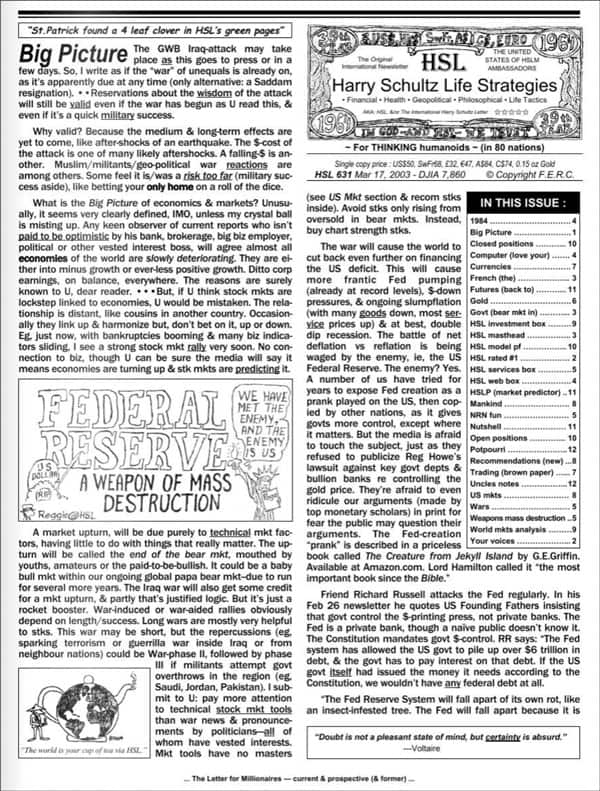
You can find many old issues of "HSL" for free on www.yumpu.com.
Anyone who witnessed these days might also remember the writing of Mark Hulbert, a US-based analyst and journalist who made it his life's work to bring some transparency into the investment newsletter sector. In 1980, Hulbert launched the Hulbert Financial Digest, a publication that tracked the performance of investment newsletters from the perspective of actual subscribers, including the timing and specificity of the buy/sell information. By 1985, he had grown his operation to 14,000 subscribers, earning him a net profit in the hundreds of thousands of dollars. In the early 1990s, the digest reportedly had over 100,000 subscribers which would have given Hulbert an income in the millions. The distinct advantage of publishing with an American audience in mind is that the sheer number of active investors in the US makes it possible to build a niche publication into a business throwing off millions without requiring much more than a laptop (or a typewriter).
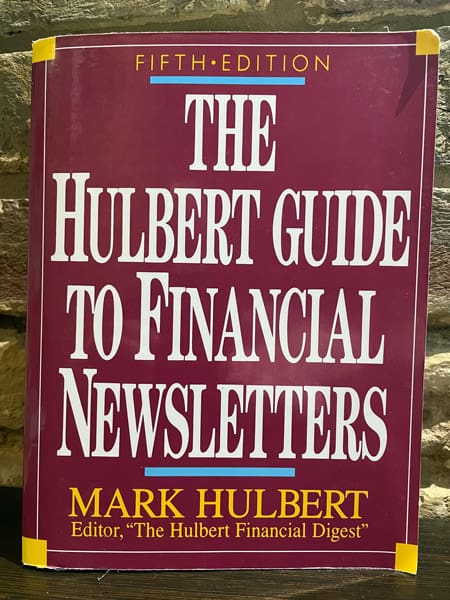
The final edition of "Hulbert Guide to Financial Newsletters", published in 1993 – available on www.abebooks.com.
The "Hulbert Guide to Financial Newsletters" became an annual guidebook for anyone who wanted to pick the best investment newsletters. Hulbert's methodology for evaluating newsletters was controversial and imperfect, and it even led to at least one lawsuit by a publisher who felt defamed. However, just having an alphabetical table of all well-known investment newsletters and how to subscribe to them was invaluable in the day and age before Internet search engines. Nowadays, we have electronic lists of newsletter-style investment publications, such as my free eBook about "The world's best investing blogs" or the overview of worthwhile publications recently released by Edwin Dorsey of The Bear Cave.
How can private investors best make use of such publications? That's a question that Hulbert delivered some timeless wisdom on.
What's a private investor to do?
In Hulbert's estimation, private investors had to keep two laws in mind.
Hulbert's First Law: "It is E-X-T-R-E-M-E-L-Y hard to beat the market over time."
Hulbert's Second Law: "It may be hard. But it can be done."
After having done more work on analysing the value and use of investment newsletters, Hulbert called them "the guerrilla troops of the financial world".
He saw their main value in delivering investment ideas that are refreshingly different from what you get from brokers and other sources of conventional investment advice, such as corporate media channels like CNBC.
As Hulbert put it in the 1993 edition of his guide:
"More recent work in academe focuses on the so-called 'anomalies' in the efficient market, peculiar areas where the market does not seem to discount information immediately and which can be exploited to achieve superior returns.
Wall Street is at a disadvantage in finding these anomalies. … The inevitable bureaucracy of large organizations makes all innovation difficult. By contrast, investment newsletter can (and do) try anything they feel like immediately. They present every conceivable investment idea, technique, and style."
For all their faults – and there are more than anyone can count – investment newsletters offer a break from conventional thinking and corporate policies. The good ones do, at least.
That's why I urge my readers:
- Don't subscribe to just one newsletter but several.
- Don't follow someone's conclusions but use them as the basis for your own research.
- Check back to older issues and reports, as they often yield valuable information and investment ideas that have become even better since they were first written up.
- Use newsletters to learn what works best for you, and to develop your own style of investing that suits your particular needs.
- Consider reading some newsletters for their sheer entertainment value and for what they teach you about the world.
Luckily for the investing public, there has recently been an explosion of choice in the field.
Enter the rise of Substack, the wider boom in alternative media, and all that it offers to investors and aspiring writers alike.
How to get help for launching your own newsletter
Publishing an investment newsletter was never particular difficult, but it always had some hurdles.
In the era before the Internet, you had to have the capital to send marketing mailings to many prospects. Sending out 100,000 marketing letters would have gained you 1,000 paying subscribers if you were successful, and it should have led to a profit during year one. However, it required putting a good chunk of money into renting address lists, printing letters, and paying postage. If the mail shot tanked, you had burned through a six-digit amount with nothing to show for.
The Internet made all that easier. From 2010 onwards, paying for subscriptions online started to become a thing. Until then, everyone expected almost everything for free. Even after Internet users had grown accustomed to paying online using their credit card, you still had to invest in setting up your own website and payment mechanism.
In 2017, Substack set out to change the game. The San Francisco-based company launched an online platform that provides publishing, payment, analytics, and design infrastructure to support subscription newsletters. Put simply, you can now launch your own investment newsletters within about half an hour.
And many do!
During the past few years, more investment newsletters and similar publications have popped up on Substack than anyone can even keep count of. Substack has boomed to such an extent that "Substack" could be on the cusp of becoming the commonly used word for "newsletter". I noticed in one Internet forum recently how Undervalued-Shares.com was called a "Substack" - even though it is not actually hosted on that platform.
I never contemplated even for one second to make myself dependent on someone else's platform. For years, I've warned about Californian tech companies going down the route of censorship. However, many newsletter authors will disagree with me, and even I admit that they have powerful arguments in their favour.
During a recent lunch with Edwin Dorsey of The Bear Cave in New York, he enthusiastically told me how he loves publishing through Substack because of the ease with which it can be done. Edwin was once featured in Institutional Investor magazine, and he disclosed that at age 23, his Substack was already bringing him annualised revenue of USD 300,000.
Indeed, there currently is one particularly strong argument for new authors to publish on Substack. Following a USD 65m funding round, the company is more helpful than ever before in getting you into the saddle. Some of the benefits on offer include Substack's support to writers in the form of stipends for health insurance, legal support through theSubstack Defender program, and mentorship opportunities through initiatives such as Substack Go. Substack even has a dedicated staff member to specifically engage with and support potential new investment writers. Now is truly a terrific time to launch a newsletter, never before have such perks been available to authors who are starting out.
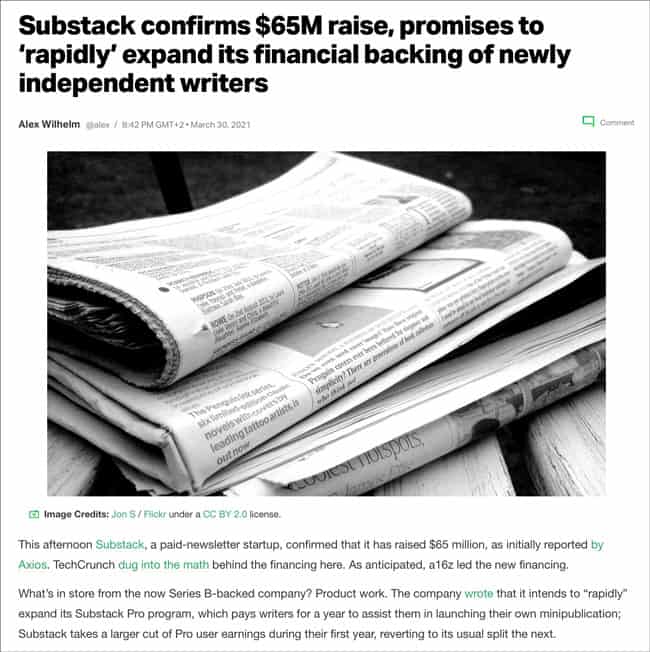
Source: TechCrunch, 30 March 2021.
Linda Lebrun is a former small-cap equity fund manager who is now the person to speak to at Substack if you are contemplating to create your own publication aimed at investors (drop her an email at [email protected]). I declined her recent offer to speak to me about Undervalued-Shares.com, but I deeply respect how knowledgeable and passionate she is about the sector and what Substack has done to grow the industry. Check out this 40-minute YouTube interview with her to form a view of your own.
I reached out to Linda for this article and asked her to briefly explain Substack's current financial prospects for new authors in her own words:
"It's phenomenal to see the success finance and investing writers are having on Substack. I've seen multiple publications go from being somebody's 'online investing journal' to being big enough to meaningfully supplement their income or even become their full-time job.
Make no mistake, the marketing part of building your newsletter requires self-promotion and strategy.
But the benefit of using Substack is, you never have to worry about the technology side, or customer service for your paying subscribers. We do all that so you can focus 100% on analysis and writing, which for most people who love capital markets, is what they most want to spend their time on."
Without a doubt, many will see this as a good deal for getting started.
Why am I increasing the amount of competition in the alternative media sector, wouldn't that be against my own self-interest? In my view, that'd be an outdated way of looking at it – akin to looking at an opportunity from a perspective of scarcity rather than abundance. I am more interested in increasing the overall size of the market. The more authors join this sector, the better for everyone. This includes the readers, who get more choice and at a lower price!
There are somewhere between 500m and 1bn private investors around the world, and the figure keeps growing thanks to phenomena such as Robinhood and Bitcoin. Trading and investing have recently become a key component in social mobility, which is a game changer for the investment-related publishing industry. Investors old and new alike are hungry for information. That's why in 2018, I relaunched Undervalued-Shares.com with an approach that makes it useful to investors the world over and affordable to everyone. I want to tap into a huge market and scale up my readership like never before. Back in 2018, few took such a plan seriously. By now, others have started to recognise the opportunity that I already saw coming a bit earlier. This is a huge growth opportunity, and one that will keep on growing for the rest of the decade.
Setting up a competing publication to Undervalued-Shares.com is probably not the kind of advice you'd expect from me, but I do urge those of my readers who are interested in writing to consider the idea.
Blog series: Subscription businesses
There's more to "Subscription businesses" than this Weekly Dispatch. Check out my other articles of this three-part blog series.
For everyone else – another subscription business idea...
... one to invest in!
If you operate a business where customers pay yearly (or monthly) and you are good at keeping your existing customers happy as well as acquiring additional customers, you can turn this into a massively valuable business.
Such has been done by my latest featured company - a world-leading subscription company that has grown by 23% over the past decade.
Its upside until 2025 is now nearly 600%.
Get the full details in my latest research report - exclusively available for Lifetime Members.
For everyone else – another subscription business idea...
... one to invest in!
If you operate a business where customers pay yearly (or monthly) and you are good at keeping your existing customers happy as well as acquiring additional customers, you can turn this into a massively valuable business.
Such has been done by my latest featured company - a world-leading subscription company that has grown by 23% over the past decade.
Its upside until 2025 is now nearly 600%.
Get the full details in my latest research report - exclusively available for Lifetime Members.
Did you find this article useful and enjoyable? If you want to read my next articles right when they come out, please sign up to my email list.
Share this post:

